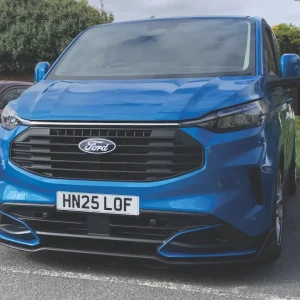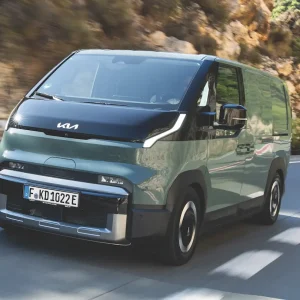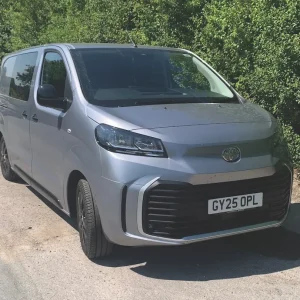In the world of pick-up trucks, the meaner looking and the bigger the truck the more people will flock to it.
VW and Mercedes both have more powerful pick-ups on sale than Ford, and yet despite that the Ranger remains resolutely the best-selling pick-up in the UK.
Why? Because it looks chunky, sounds mean and has a sort of American-cool that trades a little off the phenomenon that is the Ford F150.
Of course, the Ranger isn’t a Ford F150; for starters, it’s much smaller. Nor does it come with powerful V6 engines – the new Ranger (out later this year) must make do with a 2.0-litre diesel. There’s also a huge market for third-party add-ons for the Ranger, with an array of styling mods that can make it look just about the toughest thing on the road, and that is where we pick up the story of the Ford Ranger Raptor.
The Raptor name means something in the US, where it denotes a fire-breathing F150 monster with the engine from a Ford GT. For Europe, however, and in a Ranger, it means the stock engine from the new pick-up and bigger dimensions overall.
That’s not our attempt at selling the Ranger Raptor short; on the face of it there really isn’t much else to write home about – until you delve into the depths of the Ford Performance upgrades under the skin. For now though, sticking to the numbers, the twin-turbo 2.0-litre produces 210hp and 500Nm of torque.
While it’s an improvement over the 197hp available from the 3.2-litre five-cylinder engine used in the outgoing Ranger Wildtrak it is a little underwhelming to have so little additional oomph from a performance model, which can notch up 62mph in 10.5 seconds. So, it’s not blisteringly quick then, but it does weigh 2,510kg, which is a sizeable amount more than the standard pick-up. All that additional weight – the reason for which will become apparent – also means that payload has been severely impacted.
Normal Rangers can transport well over a tonne, but the Ranger Raptor is able to shift just 620kg, and its towing weight has plummeted too, from 3.5t to 2.5t. The long and short of it means the Ranger Raptor no longer qualifies as a commercial vehicle in the eyes of HMRC so you won’t be able to claim back the VAT on it.
The £48,785 price tag, which is more than £10,000 over the most expensive Ranger, might then put some people off.
It’s not just the price that has increased compared to the standard vehicle – it’s 168mm wider and 44mm longer, making it just over 2m wide and nearly 5.3m long. Ground clearance has also been raised to 283mm, an increase of 51mm, with the overall height of the vehicle now standing at 1,873mm thanks to the 30% increase in ride height.
Its higher stance on the road also means the approach and departure angles have increased to 32° and 24° respectively – 3° more than the standard Ranger. Other noticeable changes include the giant ‘Ford’ lettering in the grille, which takes its inspiration from the F150 Raptor, as well as the large alloy running boards along the side of the truck.
The giant wheel arch extensions make the Ranger Raptor almost as wide across its waist as it is mirror to mirror, but it doesn’t look out of proportion. The greater width is offset well by the increased height, and with the enormous BF Goodrich 285/70 R17 tyres the Ranger Raptor cuts a commanding and intimidating look. Of course, these are just the superficial changes, the adjustments made necessary to accommodate the real alterations to the Ranger Raptor – the ones that transform it from a macho-looking machine into a go-anywhere desert destroyer.


(Continued from page 1) The secret lies in the suspension with a serious tough set-up designed to allow the Ranger Raptor to conquer almost any terrain and to do it at speed as well.
The increased suspension travel comes courtesy of Fox Racing shock absorbers that have Position Sensitive Damping that allows 30% more suspension travel than in the standard pick-up.
Combined with a Watts link coil sprung rear suspension to improve road handling and comfort, the Ranger Raptor is reborn as something close to the ultimate fast off-roader.
Standard Rangers are far from unaccomplished when off-road, but the uprated suspension, which would likely set you back around £5,000 if you were to buy it separately, makes the Ranger Raptor a truly special off-roader.
And, even more amazingly, the faster you go, the better the ride quality becomes. We tested it over a variety of surfaces – from gravel and rocks to asphalt and sand – and at every turn of the wheel the Ranger Raptor effortlessly ripped its way through the terrain.
Progress is helped by the inclusion of a number of different drive settings, from the Normal mode, which allows 4×2, 4×4 or low-range driving modes, to the seriously off-road Rock setting, which is strictly for low-range four-wheel drive with both traction control and electronic stability control disengaged.
Other settings like Mud/Sand or Grass/Gravel/Snow allow some degree of slip from the wheel, while the Sport setting delivers a more responsive performance when driving on-road. Each of the settings has its merits and Ford has done a good job of making each feel different, but the real showpiece is the Baja setting.
The Ranger Raptor was designed to push into territories unknown – it’s why the satnav has a breadcrumb setting, to enable you to retrace your route. With the Baja mode engaged safety systems are disabled or significantly scaled back and the focus is on conquering mixed terrains at high speed. It’s here where the Ranger Raptor shines brightest.
The 10-speed automatic transmission – which will feature in the new Ranger as well as the Transit van – works brilliantly to keep you making decent progress over the terrain. Keep the speed high and the Raptor is able to glide over even the most rutted track or bumpy sand dune.
Obstacles that would shake you to death or merely snap the standard Ranger in half are comfortably dealt with. Want to get some serious air? Not a problem. The Raptor is keen to please and as the heavy front end begins to point back towards earth you might fear that your back is about to take a pounding, but the Fox shocks comfortably absorb the impact.
It’s a mean feat of engineering and with its heavily reinforced chassis and a special 2.3mm high-strength steel bash plate, the Raptor is certainly a credible high-performance off-roader. But as capable as the Ranger Raptor is, there are two major sticking points.
The lack of a halo engine power rating, one to really scare the competition and to live up to the Raptor ethos, is a little disappointing, and the 630kg payload does pose cost issues.
But if you can live with the sizeable price premium and can pay the VAT upfront there is no denying that the Ranger Raptor is the ultimate pick-up and a major upgrade to a fancy aftermarket grille.
Ford Ranger Raptor
Price (inc VAT) £48,775
Load length 2,317mm
Load width 1,560mm
Gross payload 620kg
Engine size/power 2.0-litre/210hp
Combined fuel economy 31.7mpg
CO2 233g/km
Comment: Alternatives to electric future?
“The future of the electric LCV requires knowing what the size of the future LCV needs to be.” That was the phrase used by Denis Le Vot, the new senior vice-president of the LCV Business Unit for the Renault-Nissan Alliance, during a private discussion at the reveal of the new Renault Master and Trafic.
Despite Renault being the primary player in the electric light commercial vehicle market, Le Vot said it is still “looking for the transition between internal combustion engine (ICE) vehicles and EVs”.
In basic terms, what he is saying is that the profits for electric vans aren’t quite there yet and while the economies of scale ramp up and the alliance leverages them, it’s just possible that Renault and partners will be looking at the alternatives.
Le Vot didn’t discount range-extenders becoming part of the Renault line-up of vans and even mentioned the possibility of a hydrogen-powered Master model. And while he says they are looking at that timeframe between ICEs and electric vehicles they are also considering what will be the alternative to a pure EV.
It would seem that while everyone else jumps on the electric bandwagon, those already in the driving seat are already looking elsewhere.
George Barrow is the UK judge for the International Van of the Year, the prestigious prize awarded by leading European LCV journalists.
The International Van of the Year report is sponsored by






